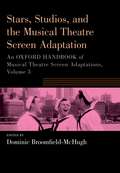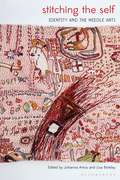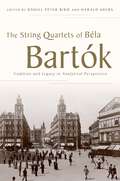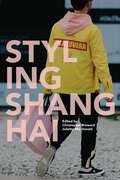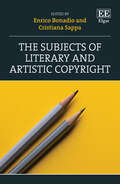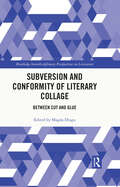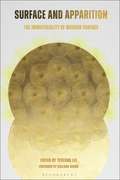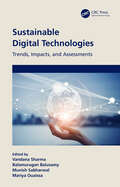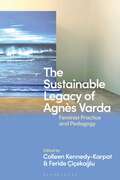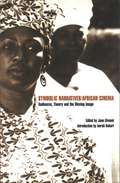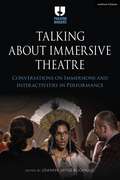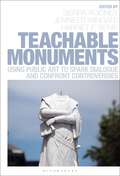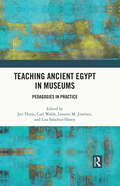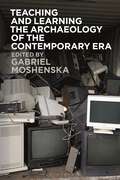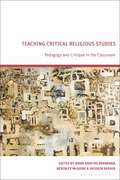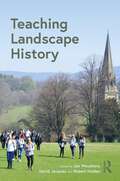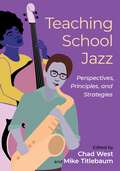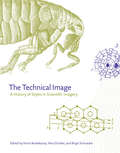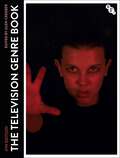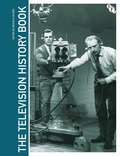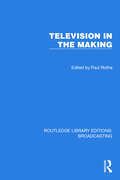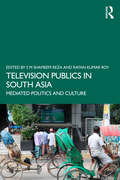- Table View
- List View
Stars, Studios, and the Musical Theatre Screen Adaptation: An Oxford Handbook of Musical Theatre Screen Adaptations, Volume 3 (OXFORD HANDBOOKS SERIES)
Hollywood's conversion to sound in the 1920s created an early peak in the film musical, following the immense success of The Jazz Singer. The opportunity to synchronize moving pictures with a soundtrack suited the musical in particular, since the heightened experience of song and dance drew attention to the novelty of the technological development. Until the near-collapse of the genre in the 1960s, the film musical enjoyed around thirty years of development, as landmarks such as The Wizard of Oz, Meet Me in St. Louis, Singin' in the Rain, and Gigi showed the exciting possibilities of putting musicals on the silver screen. The final of three volumes, Stars, Studios, and the Musical Theatre Screen Adaptation: An Oxford Handbook traces how stardom and technology has affected the evolution of the genre of the stage-to-screen musical. Many chapters examine specific screen adaptations in depth, with case studies on the screen versions of Broadway favorites Carousel and Brigadoon, while others deal with broad issues such as how music rights affected how studios approached screen adaptations. Together, the chapters incite lively debates about the process of adapting Broadway for the big screen and provide models for future studies. Volume I: The Politics of the Musical Theatre Screen Adaptation Volume II: Race, Sexuality, and Gender and the Musical Screen Adaptation Volume III: Stars, Studios, and the Musical Theatre Screen Adaptation
Stitching the Self: Identity and the Needle Arts
The needle arts are traditionally associated with the decorative, domestic, and feminine. Stitching the Self sets out to expand this narrow view, demonstrating how needlework has emerged as an art form through which both objects and identities – social, political, and often non-conformist – are crafted.Bringing together the work of ten art and craft historians, this illustrated collection focuses on the interplay between craft and artistry, amateurism and professionalism, and re-evaluates ideas of gendered production between 1850 and the present. From quilting in settler Canada to the embroidery of suffragist banners and the needlework of the Bloomsbury Group, it reveals how needlework is a transformative process – one which is used to express political ideas, forge professional relationships, and document shifting identities.With a range of methodological approaches, including object-based, feminist, and historical analyses, Stitching the Self examines individual and communal involvement in a range of textile practices. Exploring how stitching shapes both self and world, the book recognizes the needle as a powerful tool in the fight for self-expression.
The String Quartets of Béla Bartók: Tradition and Legacy in Analytical Perspective
Béla Bartók (1881-1945) was one of the most important composers and musical thinkers of the 20th century. His contributions as a composer, as a performer and as the father of ethnomusicology changed the course of music history and of our contemporary perception of music itself. At the center of Bartók's oeuvre are his string quartets, which are generally acknowledged as some of the most significant pieces of 20th century chamber music. The String Quartets of Béla Bartók brings together innovative new scholarship from 14 internationally recognized music theorists, musicologists, performers, and composers to focus on these remarkable works from a range of theoretical and methodological perspectives. Focusing on a variety of aspects of the string quartets-harmony and tonality, form, rhythm and meter, performance and listening-it considers both the imprint of folk and classical traditions on Bartók's string quartets, and the ways in which they influenced works of the next generation of Hungarian composers. Rich with notated music examples the volume is complemented by an Oxford Web Music companion website offering additional notated as well as recorded examples. The String Quartets of Béla Bartók, reflecting the impact of the composer himself, is an essential resource for scholars and students across a variety of fields from music theory and musicology, to performance practice and ethnomusicology.
Styling Shanghai
Styling Shanghai is the first book dedicated to exploring the city's fashion cultures, examining its growing status as one of the world's foremost fashion cities. From its origins as an international treaty port in the 19th century, Shanghai has emerged as a global leader in the production, mediation and consumption of fashion. This book reveals how the material and imaginative context of this thriving urban centre has produced vivid interpretations of fashion as object, image and idea.Bringing together contributions by a range of leading international fashion historians and theorists, and drawing on extensive original research, Styling Shanghai offers an interdisciplinary analysis of the mega-city's shifting position as a fashion capital. Rooted in collaboration between leading UK, Australian and Shanghai-based institutions, it considers the impact of local and global textile manufacturing, the representation and marketing of 'Shanghai Style', bodies and gender in the 'Paris of the East', and the challenges of globalization, commercialization and digital communication in contemporary Shanghai.
The Subjects of Literary and Artistic Copyright
This accessible and innovative book examines to what extent copyright protects a range of subjects which are engaged in the creation and management of literary and artistic works, and how such subjects use copyright to protect their interests.Offering a complementary analysis, The Subjects of Literary and Artistic Copyright explores how copyright regulates the production and management of literature and art. The book examines the creators of literature and art, as well as market operators such as publishers and “managers” including museums, galleries, and universities. The perspectives offered cover a diverse range of subjects, and confront the regular contradictions and conflicts that occur within literary and artistic copyright interests. The chapters illustrate, via historical and empirical analysis, that established practices and traditional approaches to the management of copyright need to be revisited, in order to be more aligned with current social and technological frameworks.Providing a starting point for future research paths on copyright practices in art and literature, this insightful book will be of interest to legal academics looking to expand their knowledge of literary and artistic copyright. Law professionals with interests in intellectual property and art law will also benefit from its novel approach.
Subversion and Conformity of Literary Collage: Between Cut and Glue (Routledge Interdisciplinary Perspectives on Literature)
Subversion and Conformity of Literary Collage: Between Cut and Glue fills a gap in the current scholarship on literary collage, by addressing how different the interpretations of the concept are, depending on the author who uses the concept and the material and writers surveyed. The book studies writers who employed literary collage during the twentieth and twenty-first centuries, some whose works have been intensely analyzed from this perspective (William S. Burroughs and Walter Benjamin), but also some whose collage-writing style has recently been investigated by writers, being usually placed under the umbrella term of artist books (Stelio Maria Martini).
Surface and Apparition: The Immateriality of Modern Surface
Surface is one of the most intensely debated topics in recent arts, humanities and social science scholarship. The changing technologies which manufacture the actual and virtual surfaces of today are radically altering our perception of thresholds and borders. In contrast to the responses to preceding industrial revolutions, contemporary concerns with surface seem preoccupied with its function of mediation or passage, rather than with that of separation or boundary. In Surface and Apparition, each chapter explores a different meaning and function of the material and immaterial qualities of 'surface'.Case studies include various surfaces from computer screens, 'artisanal' engines and glass architecture to gauzy veils, the planetary surface of supply chain capitalism, and spatial embodiment in street markets. International scholars of design, architecture, film, media, fine art, fashion, textiles, silversmithing, woodworking and archival practices account for how the material and the immaterial draw attention to each other in both their everyday and artistic practice. Each chapter addresses particular systems (from the human body to manually operated tools and machines); materials (for instance cloth, wood and light); modes of attention, movement and engagement. 'Surface' therefore functions in this book as a multidisciplinary method for attending to critical issues concerning human creative and technological endeavours.
Sustainable Digital Technologies: Trends, Impacts, and Assessments
This book is a reference on digital technology and its impact on sustainability, providing insight into sustainable practices globally. It focuses on the critical practices leading to sustainable initiatives among various organizations, IT infrastructure, communities, and government compliance. The book describes the green computing paradigms and the impact of a circular economy with a focus on sustainable practices in a post-pandemic world. Sustainable Digital Technologies: Trends, Impacts, and Assessments discusses the critical factors leading to sustainable initiatives in a global economy. It highlights the impact of digital technology and Industry 4.0 in today’s world. The book focuses on the role, responsibility, and the effect of the Internet of Things for digital sustainability and practices. It describes implementation strategies for green cloud computing and presents additional strategies for sustainable practices in a post-pandemic world. This publication is designed for use by technology development academicians, data scientists, industrial professionals, researchers, and students interested in uncovering the latest innovations in the field and the current research on problem-oriented processing techniques in sustainable and evolutionary computing applications with reduced energy channelization.
The Sustainable Legacy of Agnès Varda: Feminist Practice and Pedagogy
Drawing especially on the encounters and relationships that defined her exceptional career, The Sustainable Legacy of Agnès Varda outlines a sustainable legacy for the celebrated director and visual artist. Over nine chapters, it unpacks how creation, connection, and environment form the core of Varda's artistry, which centers foremost on relationships with her family, with other artists, even with passersby she would meet in her travels around the world. Also celebrating her feminist legacy, the chapters cover a wide range, from the classic Cléo from 5 to 7 (1962) to documentaries The Beaches of Agnès (2008) and Faces Places (2017) as well as selected art installations. The book's final section is dedicated to teaching Varda's work; here, ten scholars from around the world consider how Varda's art and feminist pedagogies offer unique ways to bring crucial concepts into the classroom. By seeking a sustainable praxis to discuss and teach Varda's work, and by making pedagogical concerns an explicit part of this approach, this book argues that Varda's insights about the nature of creative work will inspire new generations of viewers and audiences.
Symbolic Narratives/African Cinema: Audiences, Theory and the Moving Image
In the conference Africa and the History of Cinematic Ideas held in London in 1995, film-makers, cultural theorists and critics gathered to debate a range of issues. Views were exchanged on such topics as imperialism, and the problems of distribution.
Talking about Immersive Theatre: Conversations on Immersions and Interactivities in Performance (Theatre Makers)
How do theatre makers in Britain produce immersive, participatory experiences for audiences? How are productions designed and rehearsed, and how can the experience of different companies inform your own practice and understanding of this burgeoning craft?This collection of original discussions with some of Britain's leading immersive and interactive theatre makers explores their processes, methods and practices, offering a behind-the-scenes tour of how they make their work. It provides new material addressing a range of previously undisclosed topics including approaches to casting and rehearsal strategies, through to more concrete concerns such as funding and finance models. They reveal the discrete nuts and bolts of building audience-experience, and candidly discuss their own position to the term 'immersive' and how they perceive their place within the wider experience-centric cultural landscape.This collection combines perspectives from practitioners across the spectrum of immersions and interactivity in performance to showcase working methods across a variety of forms; from one-on-one, to gamified, playable experiences. The diversity of conversations captured in this volume reflects the polyphony of the immersive and interactive landscape in Britain, introducing readers to the work of Les Enfants Terrible, Parabolic, COLAB Theatre, The Lab Collective, Cross Collaborations, and ZU-UK. Makers participate in frank dialogue that reveals the ways in which they employ scenography, design, game and structural mechanics, approaches to stage management tactics, as well as the development of audience relationships, the role of intimacy and agency.
Teachable Monuments: Using Public Art to Spark Dialogue and Confront Controversy
Monuments around the world have become the focus of intense and sustained discussions, activism, vandalism, and removal. Since the convulsive events of 2015 and 2017, during which white supremacists committed violence in the shadow of Confederate symbols, and the 2020 nationwide protests against racism and police brutality, protesters and politicians in the United States have removed Confederate monuments, as well as monuments to historical figures like Christopher Columbus and Dr. J. Marion Sims, questioning their legitimacy as present-day heroes that their place in the public sphere reinforces.The essays included in this anthology offer guidelines and case studies tailored for students and teachers to demonstrate how monuments can be used to deepen civic and historical engagement and social dialogue. Essays analyze specific controversies throughout North America with various outcomes as well as examples of monuments that convey outdated or unwelcome value systems without prompting debate.
Teaching Ancient Egypt in Museums: Pedagogies in Practice
Teaching Ancient Egypt in Museums: Pedagogies in Practice explores what best practices in museum pedagogy look like when working with ancient Egyptian material culture. The contributions within the volume reflect the breadth and collaborative nature of museum learning. They are written by Egyptologists, teachers, curators, museum educators, artists, and community partners working in a variety of institutions around the world—from public, children’s, and university museums, to classrooms and the virtual environment—who bring a broad scope of expertise to the conversation and offer inspiration for tackling a diverse range of challenges. Contributors foreground their first-hand experiences, pedagogical justifications, and reflective teaching practices, offering practical examples of ethical and equitable teaching with ancient Egyptian artifacts. Teaching Ancient Egypt in Museums serves as a resource for teaching with Egyptian collections at any museum, and at any level. It will also be of great interest to academics and students who are engaged in the study of museums, ancient Egypt, anthropology, and education.
Teaching and Learning the Archaeology of the Contemporary Era
The tools and techniques of archaeology were designed for the study of past people and societies, but for more than a century a growing number of archaeologists have turned these same tools to the study of the modern world. This book offers an overview of these pioneering practices through a specifically pedagogical lens, fostering an appreciation of the diversity and distinctiveness of contemporary archaeology and providing an evidence base for course proposals and curriculum design.Although research in the field is well established and vibrant, making critical contributions to wider debates around issues such as homelessness, migration and the refugee crisis, and legacies of war and conflict, the teaching of contemporary archaeology in universities has until recently been relatively limited in comparison. This selection of carefully curated case studies from as far afield as Orkney, Iran and the USA is intended as a resource and an inspiration for both teachers and students, presenting a set of tools and practices to borrow, modify and apply in new contexts. It demonstrates how interdisciplinarity, practical work and radical pedagogies are of value not only for archaeology, but also for fields such as history, geography and anthropology, and suggests new ways in which we can examine our 20th- and 21st-century existence and shape our collective future.
Teaching Architecture: The New Age of Digital Design (Routledge Focus on Design Pedagogy)
In the post-COVID era, understanding the profound impact of digital technologies on design pedagogy is crucial. This book delves into experimental design education, showcasing projects utilising technology to transform creative and analytical processes.Emphasising the potential for digital-era technologies to create novel educational opportunities, the book addresses recent global events and their role in minimising educational disruptions in the evolving hybrid educational landscape. Each chapter offers case studies exploring digital technology's influence across architectural education, spanning interior design, urban planning, parametric digital design, architectural conservation, and design analysis. Contributors envision the hybrid virtual design studio’s future and discuss the collaborative role of digital technologies in urban design projects. The book analyses contemporary parametric design processes and machine learning through innovative historical case studies, examining new technologies in architectural conservation.With case studies from diverse locations, including South Africa, Turkey, the UK, and the United States, the book provides a global perspective on the influences and potential futures of digital technologies in architecture. Essential for those interested in the future of spatial design education, this book illuminates the pivotal role of technology in shaping its trajectory.
Teaching Critical Religious Studies: Pedagogy and Critique in the Classroom
Are you teaching religious studies in the best way possible? Do you inadvertently offer simplistic understandings of religion to undergraduate students, only to then unpick them at advanced levels? This book presents case studies of teaching methods that integrate student learning, classroom experiences, and disciplinary critiques. It shows how critiques of the scholarship of religious studies-including but not limited to the World Religions paradigm, Christian normativity, Orientalism, colonialism, race, gender, sexuality, and class-can be effectively integrated into all courses, especially at an introductory level. Integrating advanced critiques from religious studies into actual pedagogical practices, this book offers ways for scholars to rethink their courses to be more reflective of the state of the field. This is essential reading for all scholars in religious studies.
Teaching Labor History in Art and Design: Capitalism and the Creative Industries (Routledge Studies in Education, Neoliberalism, and Marxism)
Drawing from American history, fashion design, history of luxury, visual culture, museum studies, and women’s history, among others, this book explores the challenges, rewards and benefits of teaching business and the labor history of art and design professions to those in higher education.Recognizing that artists and designers are no longer just creatives, but bosses, employees, members of professional associations, and citizens of nations that encourage and restrain their creative work in various ways, the book identifies a crucial need for art and design students to be taught the intricacies of these other roles, as well as how to navigate or challenge them. This empirically driven study features case studies in various pedagogical contexts, including museum exhibitions, group projects, lesson plans, discussion topics, and long-term assignments. The chapters also explore how the roles of designing and making became separated, how new technologies and the rise of mass production affected creative careers, the shifts back and forth between direct employment and freelancing, and the evolution of government interventions in creative fields.With a diverse and experienced range of contributors, and providing a unique set of conceptual tools to interpret, cope with, and react to the ever-changing conditions of capitalism, this volume will appeal to educators and researchers across education, history, art history, and sociology, with interests in experiential learning, capitalism, equity, social justice and neoliberalism.
Teaching Landscape History
Landscape history is changing in content and style to address the issues of today. Experienced teachers and authors on the history of gardens and landscapes come together in this new volume to share ideas on the future of teaching history in departments of landscape architecture, archaeology, geography and allied subjects. Design history remains important, but this volume brings to the fore the increasing importance of environmental history, economic history, landscape history, cultural landscapes, environmental justice and decolonisation, ideas of sustainability and climate change amelioration, which may all be useful in serving the needs of a widening range of students in an increasingly complex world. The main themes include: what history should we narrate in the education of landscape architects? how can we recognise counter-narratives and our own bias? how should we engage the students in the history of their chosen profession? how can designers and researchers be persuaded of the relevance of history teaching to theory and practice? and what resources do we need to develop teaching of landscape histories? This book will be of interest to anyone teaching courses on landscape architecture, urban design, horticulture, garden design, architectural history, cultural geography and more.
Teaching School Jazz: Perspectives, Principles, and Strategies
Written by an experienced and diverse lineup of veteran jazz educators, Teaching School Jazz presents a comprehensive approach to teaching beginning through high school-level jazz. Thoroughly grounded in the latest research, chapters are supported by case studies woven into the narrative. The book therefore provides not only a wealth of school jazz teaching strategies but also the perspectives and principles from which they are derived. The book opens with a philosophical foundation to describe the current landscape of school jazz education. Readers are introduced to two expert school jazz educators who offer differing perspectives on the subject. The book concludes with an appendix of recommended audio, visual, digital, and written resources for teaching jazz. Accompanied by a website of playing exercises and audio examples, the book is invaluable resource for pre- and in-service music educators with no prior jazz experience, as well as those who wish to expand their knowledge of jazz performance practice and pedagogy.
The Technical Image: A History of Styles in Scientific Imagery
In science and technology, the images used to depict ideas, data, and reactions can be as striking and explosive as the concepts and processes they embody—both works of art and generative forces in their own right. Drawing on a close dialogue between the histories of art, science, and technology, The Technical Image explores these images not as mere illustrations or examples, but as productive agents and distinctive, multilayered elements of the process of generating knowledge. Using beautifully reproduced visuals, this book not only reveals how scientific images play a constructive role in shaping the findings and insights they illustrate, but also—however mechanical or detached from individual researchers’ choices their appearances may be—how they come to embody the styles of a period, a mindset, a research collective, or a device. Opening with a set of key questions about artistic representation in science, technology, and medicine, The Technical Image then investigates historical case studies focusing on specific images, such as James Watson’s models of genes, drawings of Darwin’s finches, and images of early modern musical automata. These case studies in turn are used to illustrate broad themes ranging from “Digital Images” to “Objectivity and Evidence” and to define and elaborate upon fundamental terms in the field. Taken as a whole, this collection will provide analytical tools for the interpretation and application of scientific and technological imagery.
The Television Genre Book
In this new edition of The Television Genre Book, leading international scholars have come together to offer an accessible and comprehensive update to the debates, issues and concerns of the field. As television continues to evolve rapidly, this new edition reflects the ways in which TV has transformed in recent years, particularly with the emergence of online streaming services such as Netflix, Disney+, HBO Max and Amazon Prime. It also includes a new chapter on sports TV, and expanded coverage of horror, political thrillers, Nordic noir, historical documentary and docu-drama. With analyses of popular shows like Stranger Things, Killing Eve, The Crown, Chernobyl, Black Mirror, Fleabag, Breaking Bad and RuPaul's Drag Race, this book offers a comprehensive understanding of television genre for scholars and students alike.
The Television History Book
Traces the history of broadcasting and the infludence developments in broadcasting have had over our social, cultural and economic practices. Examining the broadcasting traditions of the UK and USA, 'The Television History Book' make connections between events and tendencies that both unite and differentiate these national broadcasting traditions.
Television in the Making (Routledge Library Editions: Broadcasting #37)
Television in the Making (1956) looks at television in its infancy, with essays by the leaders of the medium at the time, people who were forging new paths as they imagined and actioned the possibilities of television.
Television Publics in South Asia: Mediated Politics and Culture
Television has a prime role to play in the formation of discursive domains in the everyday life of South Asian publics. This book explores various television media practices, social processes, mediated political experiences and everyday cultural compositions from Afghanistan, Bangladesh, India, Nepal, Pakistan and Sri Lanka. With the help of country specific case studies, it captures broad range of themes which foreground the publics and their real-life experiences of television in the region. The essays in this book discuss gendered television spaces; women seeking solace from television in pandemic; the taboo in digital tv dramas; television viewership and localizing publics; changing viewership from television to OTT; news and public perception of death; re-defining ‘the national’; theatrical television; and post truth television news, among other key issues. Rich in ethnographic case studies, this volume will be a useful resource for scholars and researchers of media and communication studies, journalism, digital media, South Asian studies, cultural studies, sociology and social anthropology.
Television Sitcom and Cultural Crisis (Routledge Advances in Television Studies)
This volume demonstrates that television comedies are conduits through which we might resist normative ways of thinking about cultural crises.By drawing on Gramscian notion of crisis and the understanding that crises are overlapping, interconnected, and mutually constitutive, the essays in this collection demonstrate that situation comedies do more than make us laugh; they also help us understand the complexities of our social world’s moments of crisis. Each chapter takes up the televisual representation of a modern cultural crisis in a contemporary sitcom and is grounded in the extensive body of literature that suggests that levity is a powerful mechanism to make sense of and cope with these difficult cultural experiences.Divided into thematic sections that highlight crises of institutions and systems, identity and representation, and speculation and futurism, this book will interest scholars of media and cultural studies, political economy, communication studies, and humor studies.
